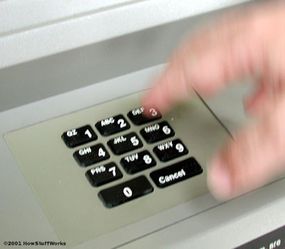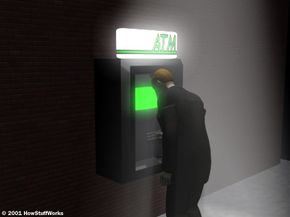ATM Security
ATMs keep your personal identification number (PIN) and other information safe by using encryption software such as Triple DES (Data Encryption Standard). But there are lots of things that you can do to protect your information and your money at an ATM.
Many banks recommend that you select your own PIN. Visa offers the following PIN tips:
Advertisement
- Don't write down your PIN. If you must write it down, do not store it in your wallet or purse.
- Make your PIN a series of letters or numbers that you can easily remember, but that cannot easily be associated with you personally.
- Avoid using birth dates, initials, house numbers or your phone number.
Visa also recommends the following tips for safe ATM usage:
- Store your ATM card in your purse or wallet, in an area where it won't get scratched or bent.
- Get your card out BEFORE you approach the ATM. You'll be more vulnerable to attack if you're standing in front of the ATM, fumbling through your wallet for your card.
- Stand directly in front of the ATM keypad when typing in your PIN. This prevents anyone waiting to use the machine from seeing your personal information.
- After your transaction, take your receipt, card and money away. Do not stand in front of the machine and count your money.
- If you are using a drive-up ATM, get your vehicle as close to the machine as possible to prevent anyone from coming up to your window. Also make sure that your doors are locked before you drive up to the machine.
- Do not leave your car running while using a walk-up ATM. Take your keys with you and lock the doors before your transaction.
- If someone or something makes you uncomfortable, cancel your transaction and leave the machine immediately. Follow up with your bank to make sure the transaction was cancelled and alert the bank to any suspicious people.
Many retail merchants close their store at night. It is strongly recommended that they pull the money out of the machine when they close, just like they do with their cash registers, and leave the door to the security compartment wide open like they do with an empty cash-register drawer. This makes it obvious to any would-be thief that this is not payday.
For safety reasons, ATM users should seek out a machine that is located in a well-lighted public place. Federal law requires that only the last four digits of the cardholder's account number be printed on the transaction receipt so that when a receipt is left at the machine location, the account number is secure. However, the entry of your four-digit personal identification number (PIN) on the keypad should still be obscured from observation, which can be done by positioning your hand and body in such a way that the PIN entry cannot be recorded by store cameras or store employees. The cardholder's PIN is not recorded in the journal, but the account number is. If you protect your PIN, you protect your account.

Related HowStuffWorks Articles
- Bank Quiz
- How Credit Cards Work
- How Banks Work
- How E-ZPass Works
- How Modems Work
- How does a magnetic stripe on the back of a credit card work?
- I've heard of bank robbers being foiled by a "dye pack" put in their money stash. What is a "dye pack"?
- When I pay for my groceries by check, where does that check go?
More Great Links
- Minnesota Bankers Association: ATM Facts
- Visa Check Cards/Debit Cards
- ATM Connection: Some Facts About ATM Machines
- Practical Guide to Analog Modems
- Asynchronous Serial Transmission
- Point-to-Point Protocol
- Telephone History Web Site
- Alexander Graham Bell's Path to the Telephone
- Glossary of Telecom Terms
- The Banker's Exchange: ATM Parts
About the Author
Jim Bowen is the service manager for GreenLink Technologies, Inc.
